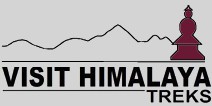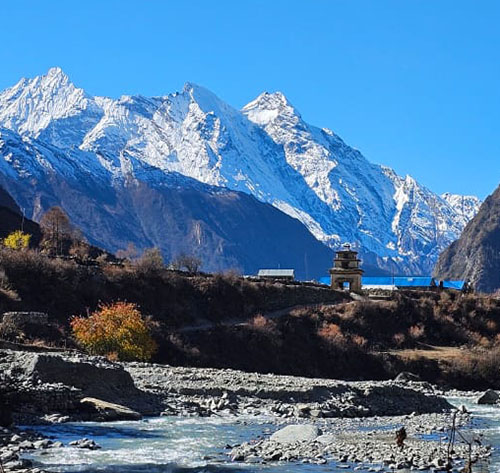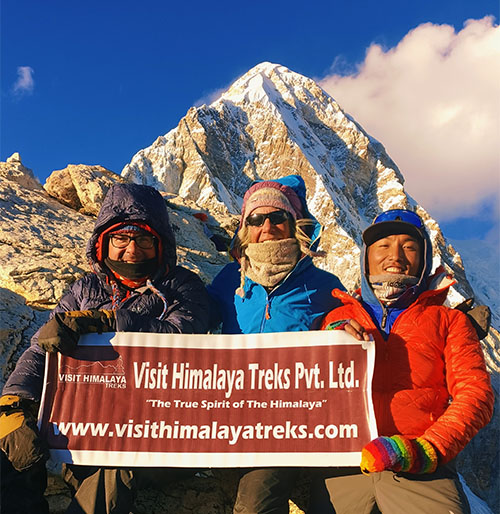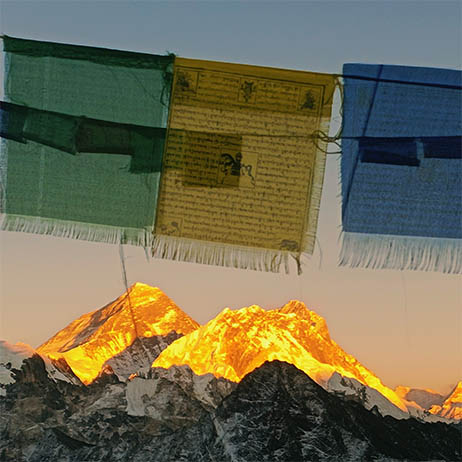Planning to go on the mythical Everest Three High Pass Trek? Before you start packing your bag, do you want to know the cost breakdown for this challenging Himalayan trek? We Visit Himalaya Treks guides you, from mandatory permits and guide, porter, accommodation, meals, transportation, and miscellaneous charges. No matter if you are traveling alone, with a partner, or in a group, we can help you estimate your budget, avoid surprises, and derive the maximum advantage out of your trekking Holidays In Nepal.
The Everest Three High Pass Trek is an adventure of a lifetime for seasoned travelers, linking Everest Base Camp to three legendary passes: Kongma La (5,535m), Cho La (5,420m), and Renjo La (5,360m). It offers unparalleled viewpoints on Everest, Lhotse, Makalu, and Cho Oyu, blended with Sherpa culture and high-altitude adventure. But how much do you need to budget for this iconic trek? Let's look at the costs and factors that decide your trekking budget.
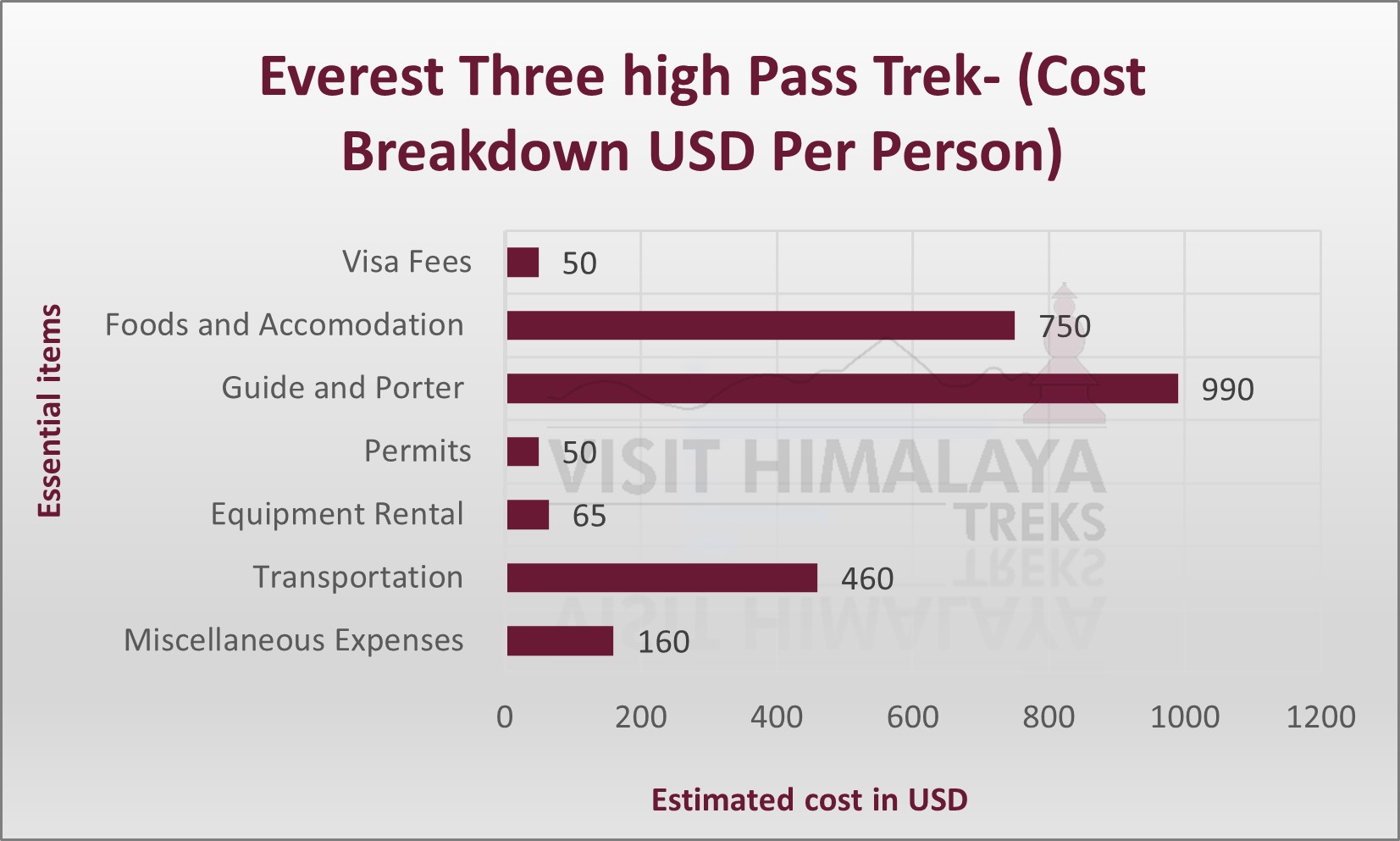
Everest Three High Pass Trek Package Cost Chart.
Introduction to the Everest Three Pass Trek.
The Everest Three High Pass Trek is one of the adventurous and popular treks in the Khumbu region, designed for experienced trekkers wanting more than just the classic Everest Base Camp route. Over 18–22 days, you’ll traverse the three major high passes, Kongma La (5,535m), Cho La (5,420m), and Renjo La (5,360m), while also visiting Everest Base Camp, Kala Patthar, and the pristine Gokyo Lakes.
1. How much does the Everest Three High Pass Trek cost?
The cost of the Everest Three High Pass Trek ranges from USD 1,800 to USD 3000 per individual for an average 18–22 day trek package. It's adjusted according to trekking season, group size, accommodation level, and transportation mode.
The Everest Three Pass Trek involves three high passes, including Everest Base Camp, Kala Patthar, and Gokyo Ri View Point. It requires a longer itinerary, extra acclimatization days, and more logistics than normal EBC treks.
What facilities are included in the trip cost?
- A standard Everest Three High Pass Trek package with Visit Himalaya Treks generally includes:
- All the permits (Sagarmatha National Park Entry, Khumbu Pasang Lhamu Rural Municipality Fee)
- Licensed English-speaking guide and porter services.
- Wages, accommodation, and food for the guide and porter.
- Accommodations at tea houses while trekking.
- Breakfast, lunch, and dinner during the trek.
- Airfare from/to Kathmandu and Lukla (round trip)
- Accommodation in Kathmandu before and after the trek as per the itinerary (3 nights 3-star standard Hotel with Breakfast)
- Company service charge and government tax.
What facilities are not included in the trip cost?
- Overseas air travel to/from Nepal.
- Travel insurance (needs to be high-altitude evacuation cover)
- Trekking gear and equipment.
- Alcoholic beverages, snacks, bottled mineral water, or hot showers during the trek.
- Tips for the guide and porters.
- Extra services or days are not included in the package.
2. Permit Fees for Everest Three High Pass Trek.
Unlike Manaslu treks, which have restricted-area permits, the Everest Three High Pass Trek lacks a restricted-area permit. However, it requires two main permits and a regular Nepal tourist visa. It requires these permits for conservation, local development, and safety tracking in the Khumbu area.
i. Sagarmatha National Park Entry Permit (SNP)
This permit covers entry into the Sagarmatha National Park, a UNESCO World Heritage Site and home to Everest and its surrounding Himalayan ecosystem.
- Cost: NPR 3,000 per head (USD 23–25)
- No seasonal adjustment
- Will be valid during the trekking period.
ii. Khumbu Pasang Lhamu Rural Municipality Entrance Permit
This local permit was implemented in 2018 as a replacement for the previous TIMS Card for the Everest area and directly benefits local infrastructure and development.
- Cost: NPR 3,000 per person (approximately USD 23–25)
- Purchased at Lukla or Monjo on arrival in the Khumbu.
All overseas trekkers require a Nepal Tourist Visa before undertaking the trek. It can be bought:
- On arrival at Tribhuvan International Airport (TIA) in Kathmandu.
- Or in advance from a Nepali embassy/consulate in your home country.
Nepal Entry Visa Charges:
- 15 days: USD 30.
- 30 days: USD 50.
- 90 days: USD 125.
For the Everest Three High Pass Trek, a 30-day visa is the preferred choice for most trekkers to accommodate the trek length, acclimatization, and potential delays resulting from Lukla flight cancellations.
Important Permit Notes
- All permits are non-transferable and non-refundable.
- Have printed copies of your permits handy for all checkpoints.
- Permits need to be bought through recognized offices or checkpoints in Nepal.
- A registered trekking agency, such as Visit Himalaya Treks, ensures that all the permits are fixed in advance to have a smooth beginning to your trek.
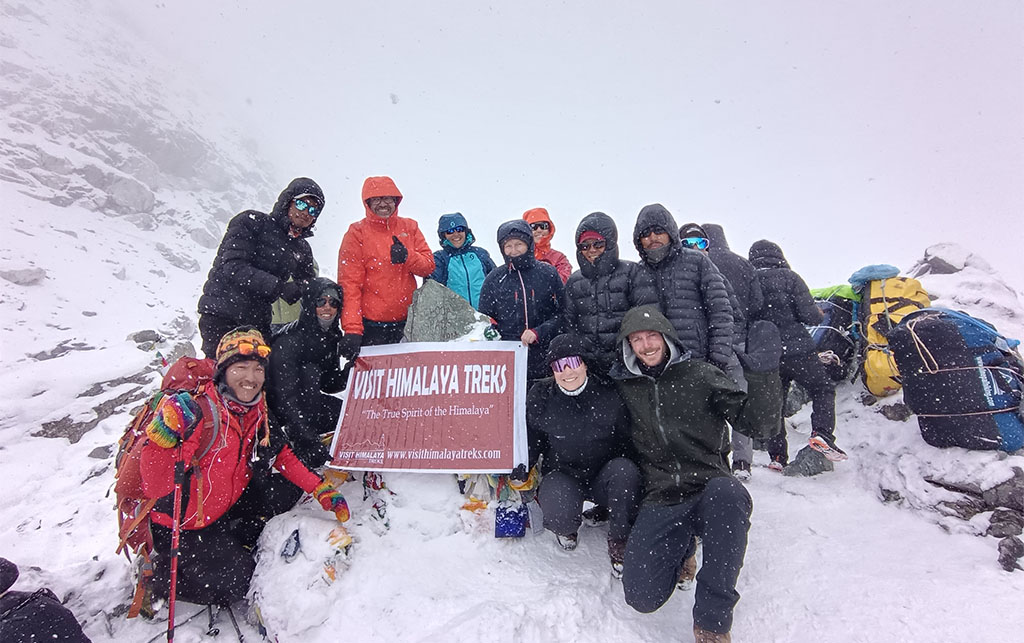
Top of Chola Pass 5420 meters, connecting EBC and Gokyo Valley en route to Everest Three High Pass Trek.
3. Porter and Guide Cost for the Everest Three High Pass Trek.
Although the Everest region does not require a licensed guide in the same way as Manaslu, the Everest Three High Pass Trek is much more complicated than the normal Everest Base Camp trek. It entails long, high-altitude days, glacier crossings, steep ascent/descent, and possible inclement weather on the passes.
Hiring a guide greatly improves your safety, allows correct acclimatization, and makes your trek more enjoyable with cultural insight. Visit Himalaya Treks provides experienced, government-licensed guides who have completed the Three Passes trek many times.
Cost of Hiring a Trekking Guide.
- A licensed, English-speaking guide typically costs USD 30–40 per day, depending on experience, language skills, and high-altitude experience.
- For an 18–22 day trek, that is around USD 660–720.
Role of the guide
- Leading and securing trekkers' safety on challenging passes.
- Monitoring altitude sickness and suggesting acclimatization methods.
- Arranging accommodation and meals at tea houses.
- Interpreting and liaison man.
- Handling logistics for emergency purposes, including helicopter evacuation if required.
Porter Hiring Cost
Your porter will usually carry 25–30 kg of total baggage for two trekkers, so you can save your energy for high passes.
- Cost: USD 20–25 per day
- Full trek cost: USD 440 -450.
Though voluntary, it is strongly suggested that one hire a porter on the Three High Pass Trek due to the physical effort, the altitude, and the duration of the trek.
Tipping Culture in Nepal
While not mandatory, tipping is also a part of the trekking culture in Nepal to show appreciation.
Suggested tipping amounts for this trek (one trekker):
- Guide: USD 200+ for the whole trek.
- Porter: US 150+ for the whole trek.
- Tips are normally left at the end of the trek, in a private or small group farewell function.
4. Food and Accommodation Cost on the Everest Three High Pass Trek.
Tea House Quality Along the Route.
Everest Three High Pass Trek passes through both busy Everest Base Camp areas as well as more remote sections like Thame, Lungden, and Dzongla. Tea houses in busy hubs like Namche Bazaar, Dingboche, and Gokyo are generally well-equipped, with better rooms, heated dining rooms, and a better selection of food. Tea houses near the high passes (i.e., Lobuche, Dzongla, Thame) are simple, with less fancy amenities due to their remote location.
A standard tea house room has:
- Twin beds with a mattress, pillow, and blanket.
- Shared toilets (squat or Western-style).
- Communal dining room, often heated by a yak-dung stove in the evening.
- Limited electricity or solar lights.
- Private bathrooms are rare in villages at higher altitudes and, where found, are available at an extra charge.
- Budget about USD 10 per room for a non-attached room.
- Budget USD 20 - 50 per room for an attached bathroom room.
Cost of Food and Beverages Per Day.
Budget USD 40–50 a day for food and drinks on the trek. The higher the altitude, the more the prices rise because supplies are flown to Lukla and carried up by porters or yaks.
Typical daily inclusions:
- Breakfast: Tea/coffee, Tibetan bread or porridge, eggs, pancakes.
- Lunch: Dal bhat (rice, lentils, vegetables), noodles, fried rice, pasta.
- Dinner: Dal bhat, soups, curries, or Pizza, pasta dishes.
- Tea/coffee breaks and snacks occasionally.
In the higher-altitude areas like Lobuche, Gokyo, and Lungden, food prices can be 40–50% higher than in Namche or Phakding.
Other Expenses for Drinks & Luxury Items.
- Bottled water: USD 1–3 per liter (higher at higher elevation)
- Hot water refills: USD 1–2.
- Soft drinks: USD 3–4.
- Energy bars/snacks: USD 2–5 per item.
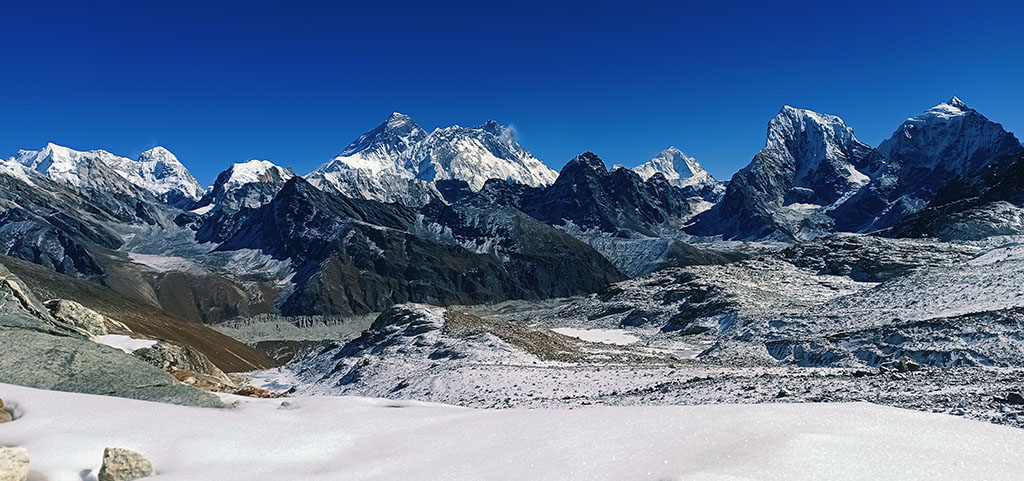
Everest view from Renjo La Pass 5360 meters, connecting Gokyo Valley and Thame Valley, en route to Everest three high Passes Trek.
5. Transport Cost to and from the Everest Three High Pass Trailhead.
Commuting to the starting point of the Everest Three High Pass Trek typically involves flying from Kathmandu / Manthali to Lukla, the gateway to the Everest region. The most convenient way of arrival is a domestic flight, which costs USD 230 per person, one way for foreign trekkers. Since it is a return trip, you should budget USD 460 per person as per the current fare.
However, Lukla's weather can be unpredictable, and flights get delayed or canceled. On such days, a helicopter ride is undertaken by some of the trekkers, and it is extremely costly—USD 500–600 per head if going with others, or more than USD 3,000 for a charter flight. Helicopters are usually used as a last option when time is limited.
For budget travelers, one can also drive to Salleri or Phaplu and then trek to Lukla, which involves 2–3 extra days of walking. It costs USD 200–250 (for the whole vehicle) for a private jeep to Salleri, and USD 25–30 per person will be charged for an ordinary jeep sharing. This saves money but comes with extra walking days before the actual start of the trek.
6. Everest Three High Pass Trek Equipment Rental Fees.
If you do not have high-altitude trekking gear, rental in Kathmandu is a cheap option. Thamel, the trekking hub, offers quality gear from inexpensive to luxury brands. Down jackets, sleeping bags, walking poles, crampons (for icy passes), and insulated gloves are essential items to rent. The prices vary according to quality and rental duration.
- Down jacket rental: USD $1–$2 per day.
- Sleeping bag rental (–20°C): USD $1–$2 per day.
- Trekking poles: USD $1–$1.50 per day.
- Crampons: USD $1–$1.50 per day.
- Microspikes or gaiters: USD $0.50–$1 per day.
Estimated Total Equipment Rental Cost: Around USD $50–$80 for the whole trek if hired for 18–20 days.
7. Miscellaneous Costs on Everest Three High Pass Trek.
Everest treks can sustain various miscellaneous costs over and beyond permits, accommodation, and guide fees. It is wise to budget for these miscellaneous expenses to avoid any unexpected surprises down the trail:
- Power charging: Most tea houses provide charging facilities for telephone, camera, and headlamp at USD 2–5 per recharge. The power is usually limited and at a premium.
- Wi-Fi: Available in larger villages like Namche Bazaar and Lukla, but slow and expensive, typically USD 3–7 per hour/day.
- Hot showers: Available at some tea houses as an extra charge of USD 3–5 per shower, which may be a luxury addition after several days of trekking.
- Snacks and drinks: Additional snacks such as energy bars, chocolate, or soft drinks can cost USD 2–5 each and are more expensive at higher altitudes.
- Tips: Although salary is covered for guides and porters, don't forget to include the budget for tipping your guide and porter at the end of the trek.
- Emergency expenses: Be sure to have travel insurance that covers helicopter evacuation, as rescue attempts are costly, maybe a few thousand dollars.
8. What determines the overall cost of the Everest Three High Pass Trek?
There are several factors that are included in your overall Everest Three High Pass Trek price, and if you know them, you can budget accordingly:
- Group Size: Private treks with personalized service are more expensive per person than joining a group trek; the cost of guides, porters, and transportation is split among many.
- Itinerary Duration: The trek typically involves 18–22 days. Side excursions, extra acclimatization days, or add-ons like the Everest Base Camp Classic will cost more due to higher accommodation and food.
- Trekking Season: High seasons (autumn: September–November; spring: March–May) usually involve higher charges due to higher demand for flights, accommodations, and guides. Off-season treks, like monsoon, will save money but pose risks from poor weather and limited services.
- Accommodation Upgrades: Budget tea houses provide basic accommodation, but it is much more expensive to upgrade to luxury lodges or boutique hotels during the course. These typically involve private bathrooms, hot showers, and a better diet.
- Mode of Transport: The most convenient but expensive means is flying to Lukla. Other jeep or helicopter transfer routes will have an impact on the total transport expense.
- Equipment Rental vs. Purchase: Renting equipment in Kathmandu is less expensive than purchasing brand new, but could curtail access to top-shelf quality items.
- Tipping Habits: Exuberance in tipping your porter and guide will significantly inflate your expenses, but it is within the cultural expectations of trekking in Nepal.

Everest Three High Passes Trek, View from Kongma La Pass (5535meters.
FAQs.
1. How physically demanding is the Everest Three High Pass Trek?
The trek is strenuous with several high passes above 5,300 meters, prolonged days of trekking, and high altitude. Good physical conditioning, previous trekking experience, and adequate acclimatization are necessary for a safe and pleasant outing.
2. Is it necessary to hire a guide and porter for the Everest Three High Pass Trek?
Even though it is not required by law like in Manaslu, it is extremely recommended to hire a guide for navigation, safety, as well as cultural reasons. Porters may also be optionally hired, but are extremely highly recommended to make your luggage lighter on longer days and on high passes.
3. What is the best time for the Everest Three High Pass Trek?
The optimum time is spring (March to May) and autumn (September to December) since the weather is constant, the skies are clear, and temperatures are mild. Winter is very cold and challenging; monsoon time is heavy rain and landslides.
4. How expensive is the Lukla flight, and are there any alternatives?
Round-trip airfares between Kathmandu and Lukla usually cost USD 460 per person with a regular flight. Alternatives include overlanding to Salleri or Phaplu and then trekking to Lukla, using extra days but being cheaper. Helicopter shuttles are available but expensive.
5. What permits are required for the Everest Three High Pass Trek, and at what cost?
You'll need the Sagarmatha National Park Permit (approximately USD 25) and the Khumbu Pasang Lhamu Rural Municipality Permit (approximately USD 25). You'll also need a Nepal tourist visa to enter.
6. Can trekking equipment be rented in Kathmandu?
Yes, Thamel in Kathmandu offers several items for rent, which includes down jackets, sleeping bags, trekking poles, and crampons. Renting is cost-effective and conserves space in the luggage.
7. How can I plan for accommodation and food on the trek?
Budget USD 40–50 per day for food and shelter, with prices rising at higher altitudes. Tea houses are from rudimentary to fairly comfortable, depending on where you are.
8. What are guide and porter tips?
Tipping is not mandatory but a welcome gesture. As an appreciation of their work for the Everest Three High Pass Trek, you can tip guides USD 200+ and porters USD 150+.
9. What insurance should I take?
Good travel insurance, including high-altitude trekking and emergency helicopter evacuation is a requirement for safety in this challenging trek.
Conclusion.
The Everest Three High Pass Trek is a Himalayan experience that combines thrilling high-altitude adventure with breathtaking views of towering peaks that are amongst the highest in the world. While the trek demands a higher budget than other treks due to the duration of the trek, permits, guide and porter needs, and transport logistics, it offers unsurpassed rewards for those travelers who are looking to push themselves and be immersed in Sherpa culture and stunning scenery.
Overall, the cost of this trek ranges from USD 1,800 to USD 3000 per person, depending on your itinerary duration, type of accommodation, time of the year, and group size. Having an idea of the breakdown of the permits, guide, and porter expenses, food and accommodation costs, transportation, and miscellaneous costs will help you plan your budget well and not incur any unexpected costs.
At Visit Himalaya Treks, we pride ourselves on transparent pricing, professional logistic support, and personalized service to make your Everest Three High Pass Trek comfortable, safe, and memorable. If you are a seasoned trekker or an adventure-seeker beginner willing to accept a challenge, our experienced guides and supportive crew are available to make your dream trip in the Himalayas a reality.
Start your journey with us and traverse the three passes, and witness the best of Nepal's culture and nature.
